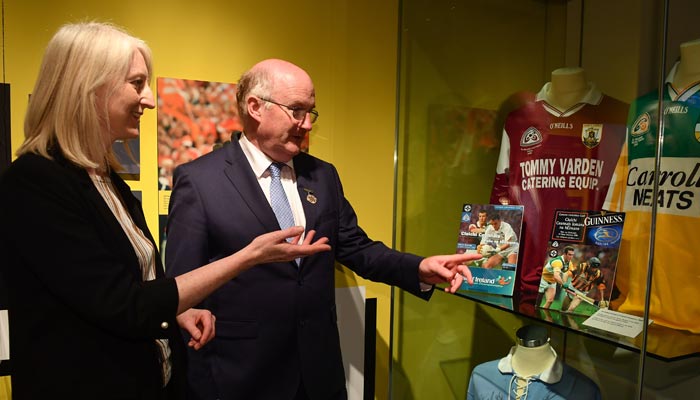- Back
Celebrating 20 years of the GAA Museum
30/08/2018
20 years might be the blink of an eye when the story you’re telling starts hundreds of years ago. However, for Joanne Clarke, Museum Curator at the GAA Museum it’s a good news story of two decades of sustained growth that today brings over 157,000 visitors a year through the door to discover or celebrate the extraordinary heritage of the Gaelic Athletic Association.
“We’re actually offering 3 distinct experiences here – the Museum tour, the Stadium tour and the Skyline tour so it’s really worth your while including Croke Park on your Dublin itinerary. Numbers have been growing steadily each year and we’re consistently high up the Trip Advisor rankings.”
With a degree in Communications, Joanne’s journey to Croke Park came via Heritage Tourism. She worked as a tour guide at prominent Office of Public Works sites - Old Mellifont Abbey, in her native County Louth, and the UNESCO World Heritage Site at Brú na Bóinne/Newgrange – before moving into a marketing role with the Department of Arts & Heritage. It was perfect preparation for her role at the GAA Museum.
“Working as a tour guide puts you face to face with visitors and refines your understanding of what works and what doesn’t when you’re storytelling. As curator of the museum my job is to tell the story of the GAA for a very broad audience, children and adults, local and overseas, leisure and corporate.
While technology plays an increasingly important role in mediating the story of the GAA and is harnessed extensively throughout the museum, Joanne strikes a note of caution about its over-deployment. Again her background as a tour guide comes to the fore.
“We favour the human touch here and place immense importance on our squad of tour guides. In our training we ensure all guides are deeply immersed in the GAA story and the museum content but they’re not required to learn a script. We want their own personalities to shine through in the storytelling. This ensures it’s authentic, person to person and always relevant to the visitor.”

The Museum is often used by the Department of Foreign Affairs as a means of showcasing and highlighting the uniqueness of Irish culture.
“Overseas corporate and diplomatic visitors are intrigued by the fact that the GAA is a strictly amateur code. They see footage here of epic battles in front of 83,000 spectators and are astonished to learn that the players will have to get up for normal work on Monday morning following such passion and commitment. They’re also blown away by the speed and skill of hurling and camogie”.
Over the past number of years the museum, stadium tour and skyline have been working more and more with the Meetings & Events team as an extension of what they offer to corporations, associations and agencies.
“Delegates don’t want to be locked up in meeting rooms all day and when they’re at Croke Park they certainly want to explore! We’ve developed joint initiatives with the Meetings & Events team and they’re going down extremely well. Some have a wellness and activity orientation – we’ve even done Yoga sessions on the skyline. Others are more culturally focused such as incorporating a museum tour during a conference lunch break. Teambuilding too is hugely popular and we’ve done many high octane treasure hunts with very competitive corporates milling around the museum exhibits.”
Experiential. Authentic. Different. Unique. Stimulating. Immersive. Motivational. These are words that organisers of meetings and events seek from their selected venues these days.
“The GAA Museum offers all of these. We have wonderful circulation space over two levels and can easily accommodate 500 for a drinks reception with a difference. We love doing events and functions as they allow us to tell our amazing story to a hugely important demographic – corporate executives and overseas conference delegates. They come for the events and then return with their own families as leisure visitors”.
And how is success measured at the GAA Museum?
“If visitors leave here feeling that they learned something they didn’t know and if they recommend us to a family member or a friend then I feel I’ve done my job as museum curator”.
- Back